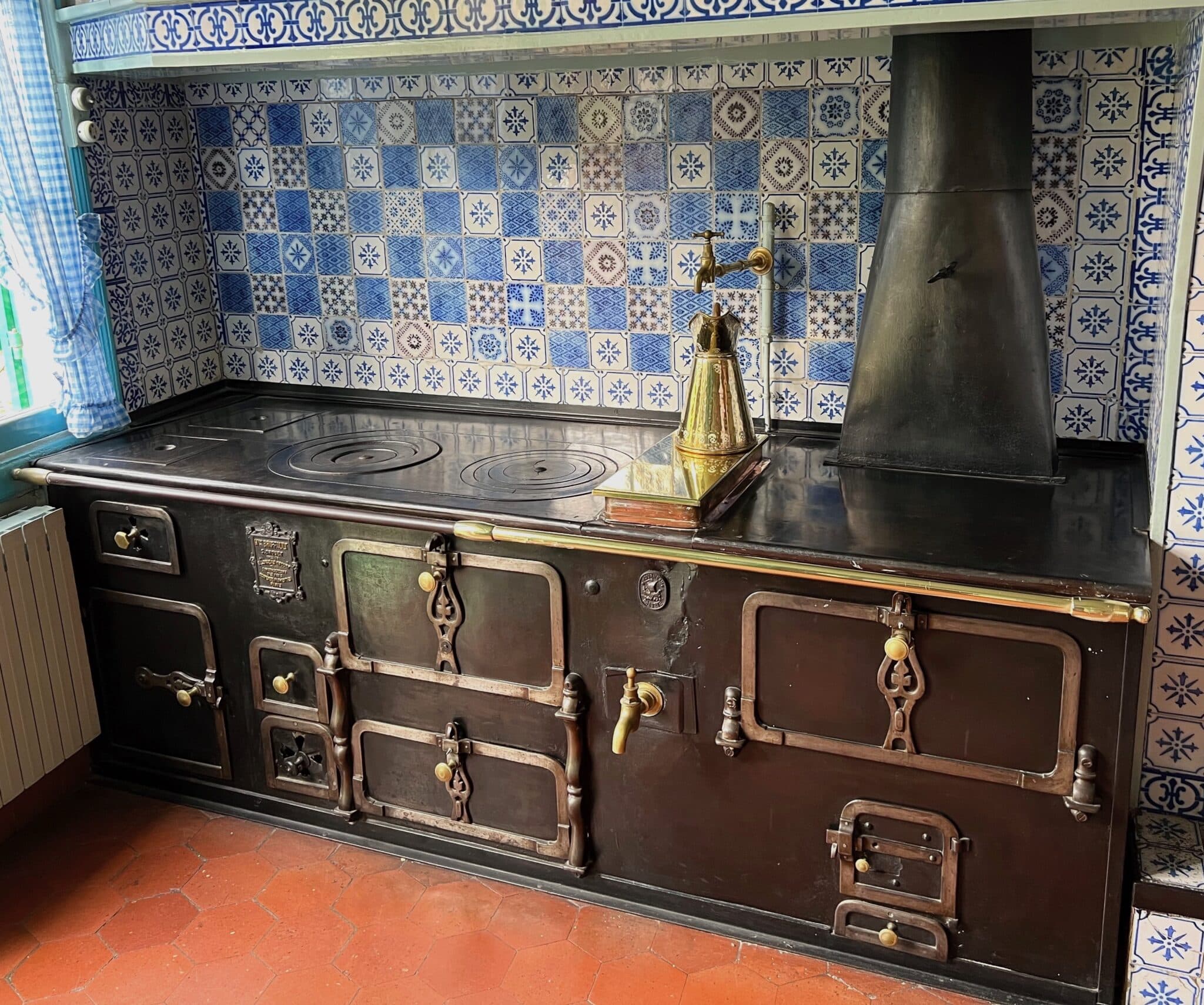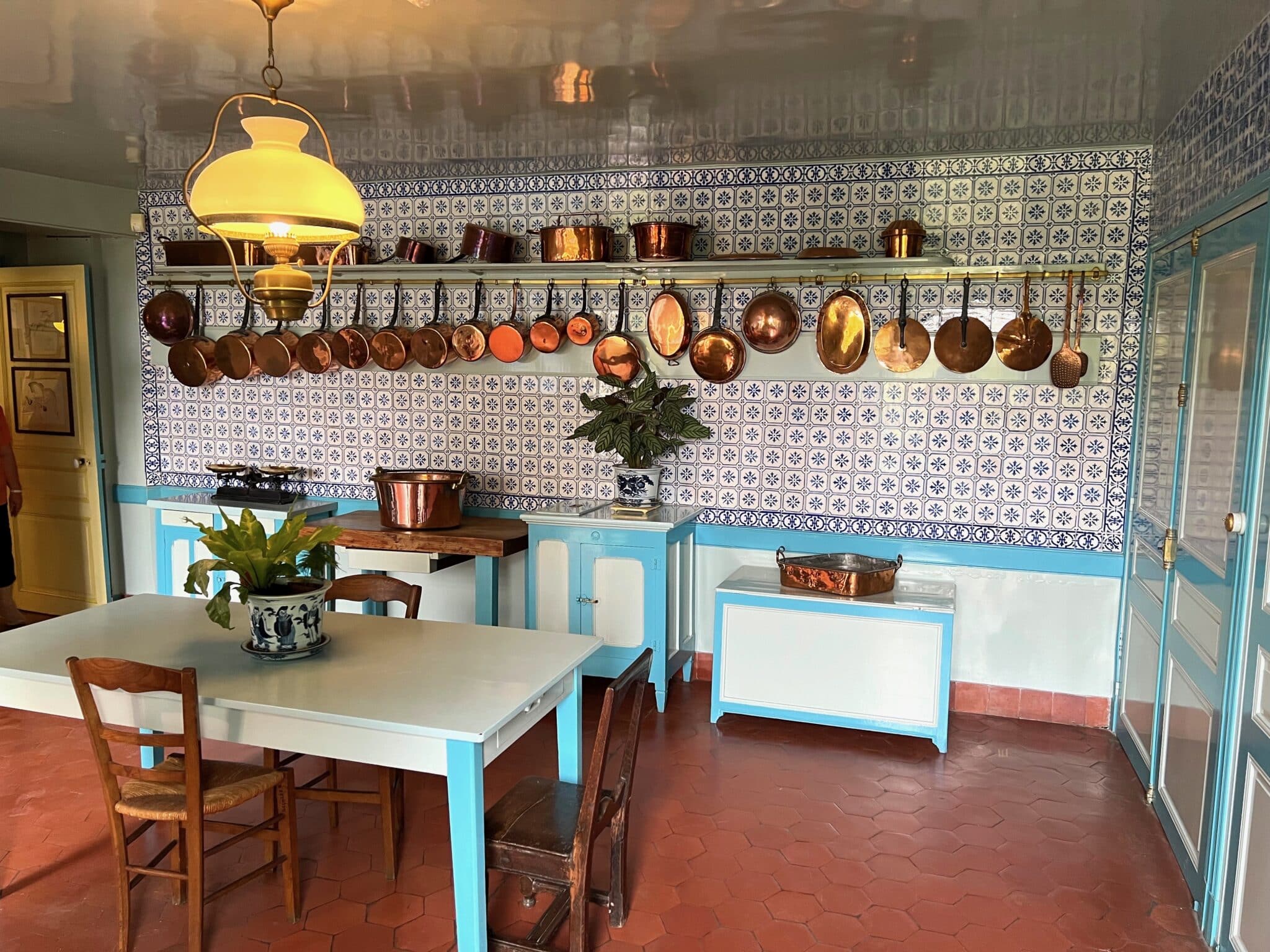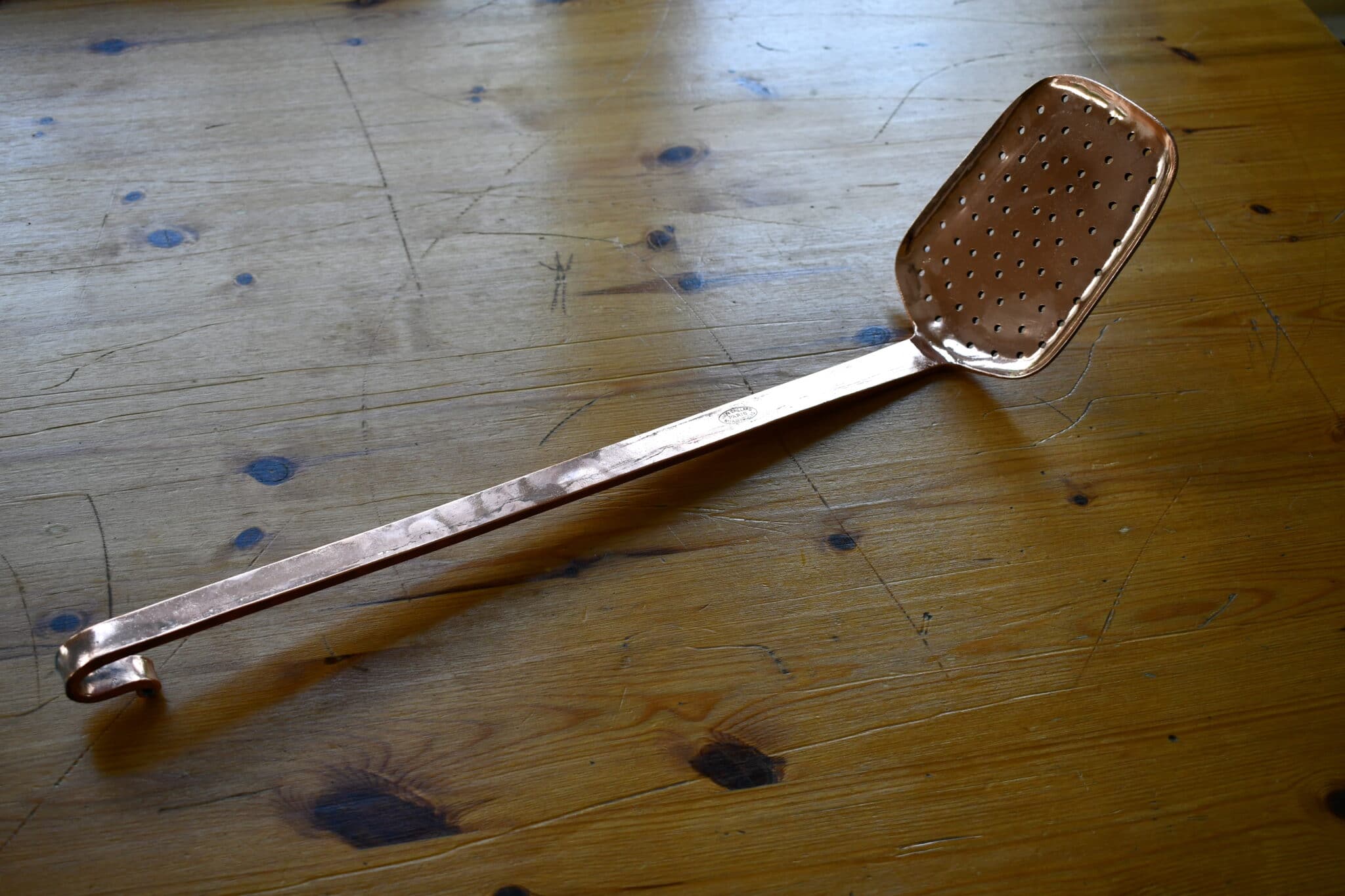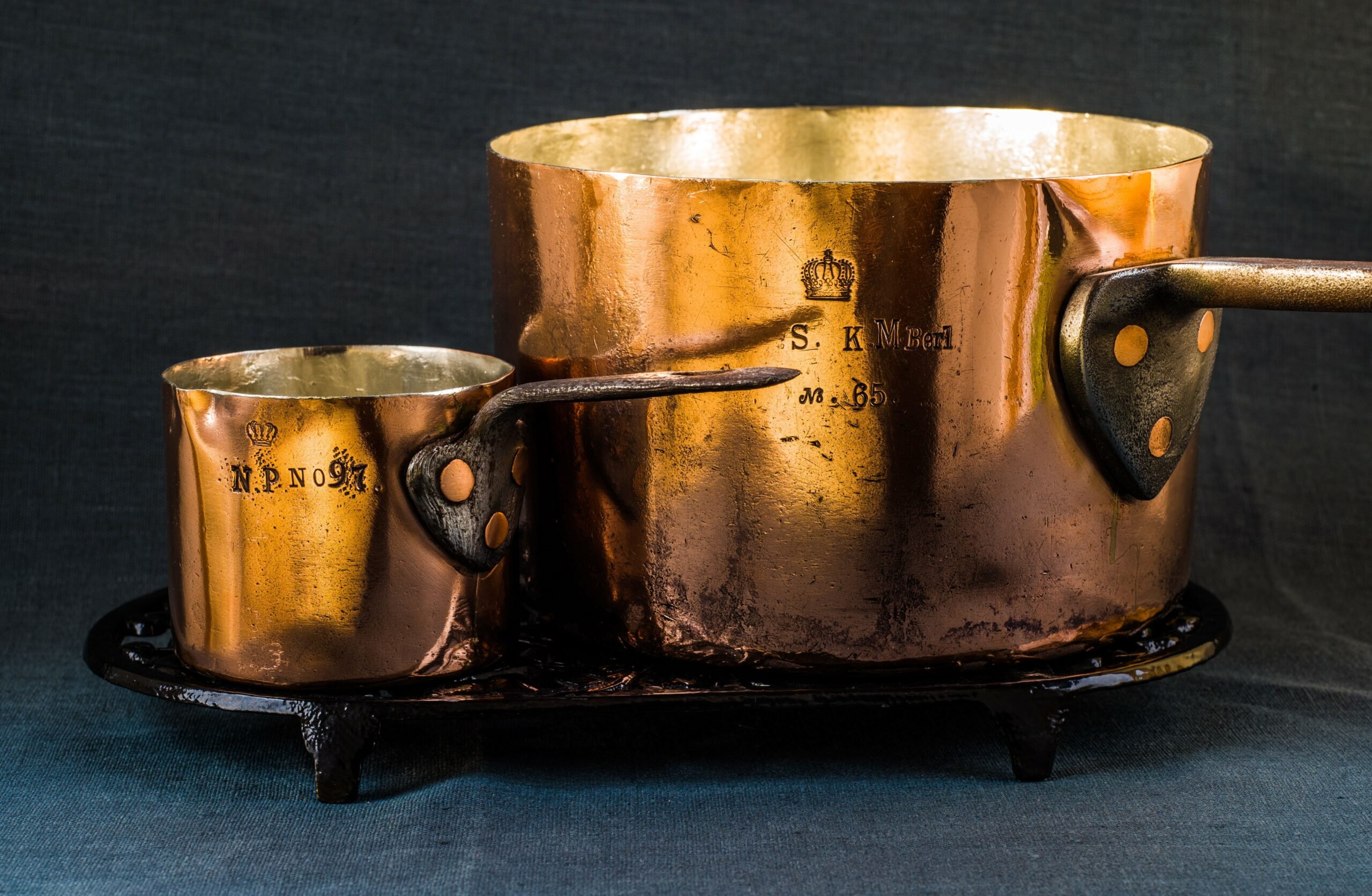There was a time in France when nickel was touted as the ideal replacement for copper.
Nickel occurs naturally in ores, but it was not until 1751 that it was first isolated and identified as an element. The first industrial process to refine and purify it was developed in 1848, and by the 1860s, metalworking firms in Paris were offering casting and plating services and trumpeting the benefits of this new metal. As the refining process was improved, metalworking firms began developing solid nickel products. In 1880, the aptly-named Nickel company proclaimed:
Pure nickel is now adopted by big industry. It is rolled and stretched as easily as copper; it makes an excellent coating on sheet iron and steel. Its very low price makes it available for general use. Its stainless nature and resistance to the action of fats, acids, sulfides and seawater give it a considerable advantage over other metals. Pure Nickel is particularly suited to household items, hydrotherapy equipment, printing rolls, sterilizing trays, dubbing of ships, roofing of houses, etc., etc., etc.
By the 1890s, nickel cookware was advertised as healthier, more economical, more durable, and ultimately more sensible than copper. Nickel is a hard metal with a high melting point and is resistant to corrosion; Chuck Lemme notes in “The Perfect Pot” that “nickel is non-toxic and has the lowest reactivity of the non-toxic metals used in cookware except for tin. It is nearly as hard as steel.” And it’s beautiful: bright silver with a slightly warm cast that does not tarnish. In 1906, Auguste Colombié, venerable co-founder of l’Académie culinaire de France and author of the Nouvelle Encyclopédie culinaire, called nickel the “perfect metal” for cookware for its excellent value and healthful qualities for the home cook:
What is the best cookware? The routine response is copper; the careless response is enameled metal; and the lazy response is cast iron.
But a serious cook will say it is a pure silver pan. Barring that, it’s the pure nickel pot of the Berndorf manufactory, very solid, and not these bazar pans as thin as paper with only a little of that “perfect metal” so that they become ugly right away and do not last. Housewives who believe themselves to be economical will prefer tinned copper, not calculating that the costs of its maintenance and polishing — in addition to the cost of purchase — raise the price high above nickel in a short period of time.
… One reaches the conclusion that it is impractical, especially in the bourgeois houses, to continue to buy copper instead of buying nickel.
By 1910, nickel cookware was a common offering at the cookware stores in Paris alongside tinned copper, enameled metal, and cast iron. Nickel pans were more expensive than the same item in copper, but stores were quick to point out their benefits and long-term cost-effectiveness. As the 1911 catalog for the Grands Magasins du Louvre put it, “We especially call the attention of ladies to our kitchen utensils IN PURE NICKEL OF ONE PIECE. The durability of these articles is almost indefinite. The maintenance is very easy and they are economical because tinning is unnecessary.”



I’ve kept an eye out for these early pans but they seem to be quite rare. Nickel is a component of stainless steel, and during the wartime periods of 1914-1918 and 1938-1945 many pure nickel items were melted down. But I have managed to pick up a few nickel pans here and there, enough to build a set.

I sent them to Erik Undiks at Rocky Mountain Retinning for a good polish and to fix some of the dents. He did an excellent job but you will notice that many of the pans still have dings and ripples in them. Erik noted that several of the pans have heat damage that renders the metal brittle, and I agreed with him that it wasn’t worth the risks of aggressive reshaping. I am quite happy with them as they are.
I’ve deciphered their stamps and discovered that this group of fourteen pots and pans consists of pieces from four different manufacturers.
Berndorf
The city of Berndorf in Austria has been home to metalworking operations since the 18th century. In 1843, Hermann Krupp and Alexander Schoeller opened Berndorfer Metallwarenfabrik, which within a few decades was expanded by Arthur Krupp into one of the largest and most successful industrial facilities in Europe. The first advertisements for Berndorfer metal products showed up in Paris in 1879, and by the 1900s, the company’s pure nickel cookware had an excellent reputation among French chefs for its thickness and durability (as demonstrated by Auguste Colombié’s endorsement above!).





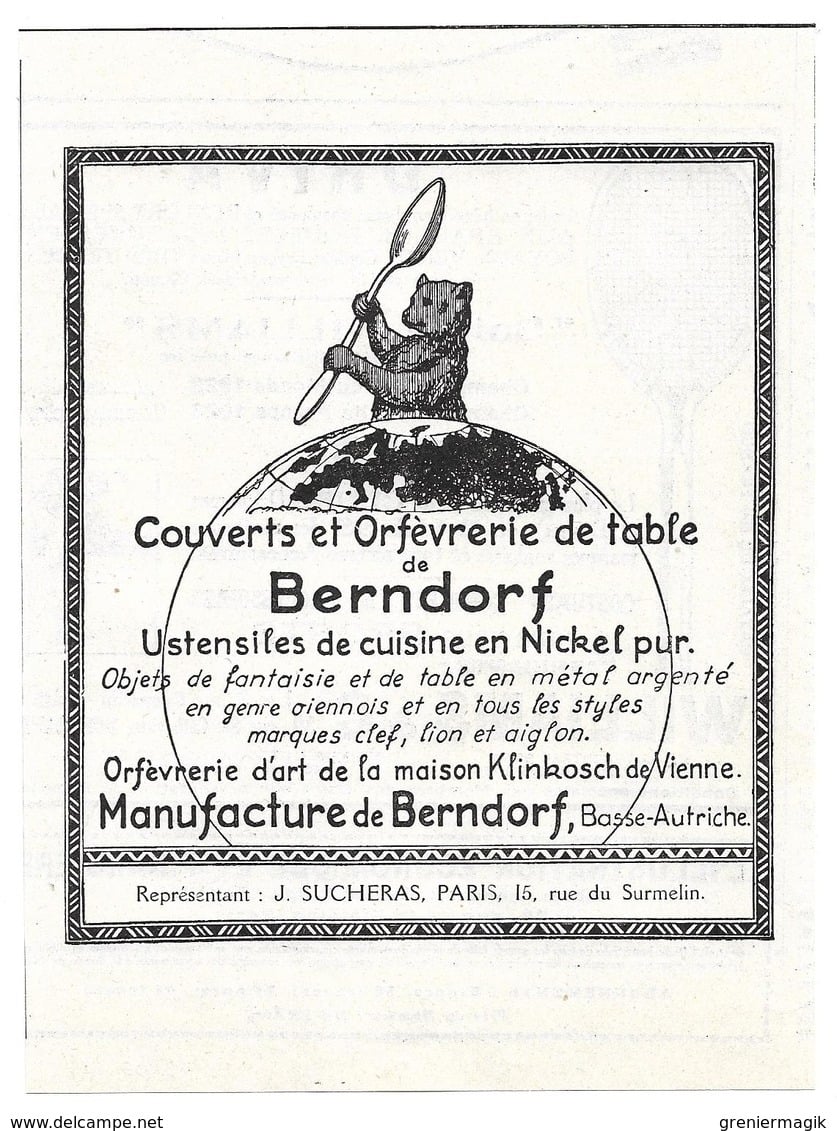
I have three Berndorf items, each with a different version of Berndorf mark.

22cm skillet
This is a nice little skillet. It’s 1.2mm thick and weighs 744g (1.6 lbs) — more substantial than the 26cm SFMO skillet you’ll see below, but still thinner than I’d like in a skillet. But it has been treated relatively well and doesn’t show signs of heat warping. The craftsmanship is lovely, with flush-set external rivets and smooth interior rivet heads. The handle is similar to a classic French style with a tapered shape, but the hanging loop is a simple oval and not the classic teardrop shape.




10cm saucepan and 12cm lid
This saucepan and the separate lid have two different Berndorf stamps, likely indicating they were made at different times, possibly in different factories.
The 10 cm saucepan is stamped “Rein-nickel,” meaning “pure nickel,” a mark that appears as early as 1892. It is also stamped “Berndorfer Metall Waaren Fabrik Vien,” indicating it was made at the Berdorf factory in Vienna. Note the “½” stamp on the baseplate, possibly referring to a half-quart capacity.
The lid is stamped with a conventional Berndorf “Nickel Pur” stamp. My guess is that it is a later piece, possibly 1930s-1940s.






Souchet et Cie.
This 12cm saucepan had a somewhat blurred stamp and it took me some time to figure out that the mark is the boar’s head of Souchet et Cie, a metalworking firm in Paris.


It’s a nice little piece. It’s 1.1mm thick — thin, but still thicker than the 12cm SFMO saucepan you’ll see below. It weighs 274g (.6 lbs). Its base is a bit battered.





Tournus
 Tournus is a city on a Saône river in the east of France, not far from the border with Switzerland. In 1910, after the phylloxera louse had killed many of the region’s vineyards, the city created a metalworking factory called Manufacture métallurgique de Tournus (MMT) to give local workers jobs making aluminum housewares (articles de ménage).
Tournus is a city on a Saône river in the east of France, not far from the border with Switzerland. In 1910, after the phylloxera louse had killed many of the region’s vineyards, the city created a metalworking factory called Manufacture métallurgique de Tournus (MMT) to give local workers jobs making aluminum housewares (articles de ménage).
I don’t know when Tournus began to make nickel cookware, but I see pure nickel items in the company’s catalogs in the 1930s. But by the 1940s, this cookware was no longer offered, likely a casualty of the second World War.
24cm stewpot
Only one nickel pan in my collection was made by Tournus: a stewpot measuring 24cm (9.4 inches) diameter. According to the 1934 Tournus catalog, this pot with lid cost 205 francs (about $10 in 1934, equivalent to about $200 in 2019); by 1938, it was 270 francs ($8 in 1934, or about $150 in 2019). It carries two stamps: “Nickel Pur Massif 24” and the standard Tournus logo. The rivets are absolutely flush to the exterior baseplate, and flush-set on the interior.





Société Française Des Métaux Ouvrés (SFMO)
This company was established in 1904 in the village of Moncey, east of Dijon in the Alsace region in eastern France. The term métaux ouvrés means “worked metals,” and the company began with housewares in aluminum. A fire in 1907 prompted the firm to relocate a few miles north to Vesoul where it operated a factory until 1969. This video, dated 1967, gives a great overview of the mix of machine-powered metalworking and hand-craftsmanship that I think was typical of 20th-century production. (The soundtrack is also fabulous.)
Its early trademark was le trefle (cloverleaf) with the initials SFMO. Later in the 20th century, the company was known simply as Metaux Ouvrés Vesoul, “Metalworks of Vesoul.” The last records I can find for the company indicate that it was closed in 1986.


SFMO pans make up the bulk of the set I’ve built.

26cm sauté pan
This is my favorite of the SFMO pieces. At 1.3mm thick and 1702g (3.75 lbs), it’s one of the most substantial of the nickel pieces I’ve assembled. It is clearly styled after a conventional copper piece. The handle is in the classic French style: the baseplate is a rounded lozenge, and the handle tapers to a teardrop-shaped hanging loop.






I’m apparently not the only one who likes this pan — it shows significant pitting from use. Nickel is supposed to be quite resistant to corrosion so I can only imagine what kind of long-term exposure to salt or acid could have caused this. I don’t consider it fatal to the pan — it’s solid nickel and the pitting only extends a fraction of a millimeter — but it likely makes the surface a little stickier for food.



20cm egg pan and 32cm gratin
An egg pan is often confused with a paella pan, and while it could certainly serve as such in a pinch, it’s sized and shaped for omelettes and is usually too small for a family-size batch of paella. This egg pan measures 20cm diameter, just under 8 inches. Its cousin the gratin measures 32cm (12.6 inches) long by 20cm wide. They are each 1mm thick; the egg pan weighs 436g (just under 1 lb), while the gratin weighs 726g (1.6 lbs).
The handles are modeled on conventional French handles, with a soft point on the lower edge of the baseplate and a handgrip that flares from narrow-set prongs.



26cm skillet
This skillet has taken a beating. The floor is quite uneven; it looks as though it’s been heated quite hot. It’s only 1mm thick and weighs a mere 768g (1.7 lbs).





10cm, 16cm, and 18cm lids
These are nice little fitted lollipop lids. They’re thin and a bit beat up, but they still fit their intended pots.


Set of five saucepans
This group includes a set of five saucepans: 12cm, 14cm, 16cm, 18cm, and 20cm. The smaller pans are 1mm thick, while the 18cm and 20cm are closer to 1.1mm thick. Pans this thin are also lightweight: the smallest at 12cm weighs a mere 418g (.9 lb), while the largest at 20cm is 1266g (2.8 lbs).
They have identical handle and baseplate styles with a slight lower point and fully flush-set exterior rivets. The handles are not the classic French style, but flatter in profile and shaped into a swoop. The hanging loop at the end is a simple oval.




20cm stewpot
This pot is virtually the twin of the 20cm saucepan above but with twin handles instead of the single stick handle. It’s also 1.2mm thick but it weighs slightly less — 1030g (2.3 lbs) — likely due to the smaller mass of the handles. It’s been well-used and has some pitting in the interior, and the base has ripples, likely from thermal expansion from overheating.





Conclusions
I can understand why at the time nickel was seen as an improvement over copper. Nickel is a hard metal with a high melting point that is food safe and resistant to corrosion, and as cookware, it doesn’t need to be relined. Though pure nickel cookware seems to have been a phenomenon limited to the period from the 1890s to the 1930s, nickel was revived as a lining for French copper cookware in the 1970s, again with the promise that it was superior to tin.
And yet we’re not all cooking on nickel. Why? Well, about 10% of the population develops contact dermatitis from handling nickel, which lead to widespread restrictions on its use in pure form in consumer goods. Though these restrictions were intended to address jewelry and other products intended for prolonged skin contact, many people now consider nickeled cookware to be vaguely unsafe, and not surprisingly, cookware manufacturers have shied away from making more of it.
And while nickel makes for a nice cooking surface, it does not provide good thermal performance. Its ability to absorb and transmit heat is about on par with that of stainless steel — in other words, dismal. Several of my nickel pans show signs of heat warping, which tells me that their former owners put quite a bit of heat into them. Is that just from careless handling, or is it a sign that these pans need a lot of heat in order to perform properly?
They’re also quite thin. Nickel is a harder metal than copper, which means that a 1mm nickel saucepan will be more resilient than the same pan in copper. I speculate that a large part of the appeal of nickel from the manufacturer’s perspective was that it didn’t take a lot of nickel to make a pot that was reasonably strong while still lightweight. And yet most of these pans have dings and dents — one millimeter is just not a lot of metal.
Ultimately, I think nickel cookware was a victim of economics. Adding just a small amount of nickel to iron and chrome to create stainless steel confers many of nickel’s advantages — its strength, its cleanliness, its non-reactiveness — at a fraction of the cost of pure nickel. The amount of nickel in one pan could produce up to twelve of the same pans in stainless steel, and this is what eventually crowded nickel out of its ecological niche.
I’m glad these pans survived — they’re beautiful, if imperfect, and I’m happy to have them. And who knows — maybe one of these days I’ll try them for cooking and report back how they compare!
Sources and Notes
Lemme, Chuck. “The Ideal Pot,” in the Oxford Symposium on Food & Cookery, 1988: The Cooking Pot : Proceedings, January 1, 1989. (ISBN: 9780907325420) For the record, Lemme did not review a pure nickel pot, but he scored “flame-sprayed nickel over 2.5mm of copper” as 729.4/1000 on his “Ideal Pot” scale, coming in second behind “*Near Ideal* SS/Nickel/Aluminum,” which eked out a win in the “Cost per Unit Volume” metric.
Colombié, Auguste (1845-1920). “La cuisine bourgeoise : traité pratique à l’usage des jeunes filles, guide indispensable de la maîtresse de maison.” A. Réty (Meulan), 1906. Available at ark:/12148/bpt6k9756262j
